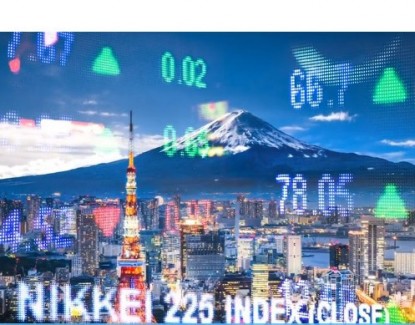Market Commentary and Fund Performance
Masa Takeda of Tokyo-based SPARX Asset Management Co., Ltd., sub-advisor to the Hennessy Japan Fund, shares his insights on the Japanese market and Fund performance.
-
 Masakazu Takeda, CFA, CMAPortfolio Manager
Masakazu Takeda, CFA, CMAPortfolio Manager
Fund Performance Review
In March, the Fund increased by 5.23% (HJPIX), outperforming its benchmark, the Russell/Nomura Total Market™ Index, which grew by 4.45%.
The month’s positive performers among the Global Industry Classification Standard (GICS) sectors included shares of Industrials, Consumer Discretionary, and Consumer Staples while Financials detracted from the Fund’s performance.
Click here for full, standardized Fund performance.
Among the best performers were our investments in Rohto Pharmaceutical Co., Ltd., a leading skincare cosmetics and OTC ophthalmic medicines producer, Hitachi, Ltd., one of Japan’s oldest electric equipment and heavy industrial machinery manufacturers and Shin-Etsu Chemical Co., Ltd., Japan’s largest chemical company.
As for the laggards, Tokio Marine Holdings, Inc., the general insurance company with the best underwriting track record in Japan, ORIX Corporation, Japan’s largest non-bank comprehensive financial services company, and Mitsubishi UFJ Financial Group, Inc., one of Japan’s largest financial groups, were the largest detractors.
At the end of 2022, we increased the number of Fund holdings as we believed there were more attractively priced securities relative to our current holdings amid last year’s market turmoil. Some of the new names, such as Tokio Marine and ORIX, we call “growth stocks in disguise” because they were trading at value-stock like multiples due to the seemingly mature state of the business. In our view, however, these companies have growth profiles that are similar to or only slightly less than typical growth holdings in the Fund (i.e. mid-high single digit vs. high-single digit to low teens) and at the same time have a significant ability to buy back shares, which helps to raise earnings per share. Plus, their payout ratio gives shareholders dividend yields of 3-5%. Hence, combining these three key components of return, the total expected shareholder return comes out to around 10% on a sustainable basis. Such a return profile is comparable to “pure” growth companies held in the Fund. Elsewhere, we have also added new investments in the semiconductor-related space in recent quarters, which we touch upon on the next page.
Since the beginning of this year, we have consolidated the Fund’s holdings into fewer positions (back to the historical average number of holdings). Going forward, while the Fund will remain invested in its long-term holdings, we will continue to actively seek for new investment opportunities and act on them if necessary. In the context of the Portfolio, a new stock candidate should contribute to:
• Enhancing the expected returns of the current Portfolio and/or
• Diversifying the risk profile of the current Portfolio
We may also seek to switch to new candidates that we believe can endure longer-term investment horizon than our existing names. Ultimately, the goal is to have a concentrated low-turnover portfolio that will do better than the broader market over time.
Two new sectors that have been added since last year are ‘semiconductors’ and ‘financials.’ We have explained why we have not included these sectors in the past in previous reports. However, the dramatic changes in the external environment in recent years have allowed us to envision a brighter outlook for their performance. These sectors are also attractive from a valuation perspective.
Firstly, semiconductors are still an industry where demand is cyclical, known as the ‘silicon cycle.’ However, as symbolized by the recent confrontation and intensifying competition between the U.S. and China, it should be positive that large investments are now being made on a medium- to long-term basis under government initiatives. For example, it is well known that TSMC (Taiwan), the world’s largest semiconductor contract manufacturer, is building new plants in the U.S. and in Kumamoto Prefecture, Japan. It is worth noting that many Japanese semiconductor-related companies are leading the industry by demonstrating their competitive advantage in manufacturing.
Why is the semiconductor industry so influential in international relations? In a nutshell, it is because semiconductors are tremendously important to a country’s economic development, both past and future (see ‘Semiconductor industry support of major countries’ below). Especially for major powers such as the U.S. and China, they should be indispensable to their quest for hegemony. In addition to personal computers and mobile phones, which have made our lives dramatically more convenient, a huge amount of semiconductors will be needed in the future in fields such as data centers and artificial intelligence (AI), as well as in the advancement of automobiles and home appliances. For example, according to a 2021 study by the British research company Omdia, the average semiconductor revenue per car was $664 for a petrol car, while it was $1,600 for an electric car, a 2.4-fold increase. The switch from 4G to 5G and then 6G mobile phones will also increase the amount of semiconductors installed per vehicle. Although demand fluctuates widely depending on economic cycles, there are few other industries in which such significant growth in volume is guaranteed, and we believe that this is an area that cannot be ignored for growth investors. In particular, Japan is home to some of the world’s industry leaders. These companies have grown in tandem with the technological development of the semiconductor industry, and many of them have long-term track records that meet our investment criteria in terms of profitability, return on capital and cash flow generation. Above all, the decline in share prices of semiconductor-related stocks in the second half of last year has increased the investment appeal of these companies compared to our existing holdings, which is another major reason why we started investing in these companies.
Semiconductor Industry Support in Major Countries
USA:
• Passage of the National Defense Authorization Act (NDAA 2021), which includes subsidies of up to JPY 300bn ($2.2bn) per case and the establishment of a ‘multilateral semiconductor security fund’
• President Biden supported the CHIPS bill, which included $52bn (approximately JPY 5.7tn) for semiconductor industry investment
China:
• Established the National Integrated Circuit Industry Investment Fund (2014, 2019) and made large-scale investments totaling over JPY 5tn ($37.4bn) in semiconductor-related technology
• In addition to this, local governments have funds for the semiconductor industry totaling over JPY 5tn ($37.4bn) - over JPY 10tn ($74.7bn) in total
Europe:
• Published digital strategy for 2030. Investment of EUR 134.5bn (approx. JPY 17.5tn/$130.8bn) in digital transition (logic semiconductors, HPC/quantum computers, quantum communication infrastructure, etc.), etc.
Taiwan:
• Launched subsidies and other incentives to encourage investment back into Taiwan. Applications for investment totaling JPY 2.7tn ($20.2bn) have been received, mainly in the high-tech sector (January 2019)
• Announced plans to inject a total of JPY 30bn ($224mn) in subsidies into the semiconductor sector by 2021
South Korea:
• JPY 100bn ($747mn) earmarked for investment in AI semiconductor technology development (Dec 2019)
• Announced a plan to invest more than JPY 500bn ($3.7bn) intensively in technological development in the materials, components and equipment industries, including semiconductors, by 2022 (July 2020)
• Formulate the ‘K-Semiconductor Strategy’ to become a comprehensive semiconductor powerhouse (May 2021)
(Source: Daiwa Securities)
We have avoided the financial sector due to the low growth potential of the Japanese financial industry, but we believe that the first signs of a real rise in interest rates in 40 years, triggered by the phenomenon of inflation in Japan, represents a significant change. In Japan, where negative interest rates have continued, it may be more correct to say that the interest rate environment is slowly normalizing. In other words, it is reasonable to select stocks on the assumption that the current situation is abnormal and that the situation will return to normal. Banks, non-banks, and insurance are examples of industries where normalization of interest rates could make business more attractive. Banking and non-banks will be able to secure the profit margins they should earn in their core lending and leasing businesses, while insurance will see a positive effect in terms of premium management. These domestic companies have a long history and a solid long-term track record. They have long lacked growth potential, and their low share price valuations and lack of new entrants are also attractive. In addition, as we have previously explained, the major domestic non-life insurers are well positioned to invest aggressively in overseas growth, thanks to their ample profits from oligopoly and the capitalization of their large policy holdings.
In March, the financial system’s instability overseas suddenly became apparent due to the significant rise in global interest rates started last year. While some believe that this has eliminated (or even distanced the elimination of) negative domestic interest rates, we are closely watching the possibility of continued structural inflation. Even if there is an economic slowdown, there will still be a structural shortage of labor due to 1) an ageing workforce, 2) restrictions on immigration, and 3) changing lifestyles where people prioritize leisure time over work. Workers will continue to demand wage increases when real wages decline due to inflation. This leads to price increases by companies, which in turn leads to higher prices, which in turn causes real wages to decline again, creating further upward pressure on wages, creating a vicious cycle. Furthermore, the recent global trend towards ESG (environmental, social, and governance) investment and environmental initiatives are also seen as potential inflationary factors, as they will drive up the cost of doing business for companies in the long term.
The current economic environment is at a delicate juncture: if interest rates continue to rise, some foreign financial institutions will face a financial crisis, while if interest rates stop rising, inflation may accelerate. In Japan, on the other hand, unprecedented wage increases have started in the current spring labor negotiations, and the possibility of an inflationary economic revival is not zero. We do not make detailed forecasts on inflation. However, we do believe that there are attractive companies whose share prices will become undervalued as their businesses improve significantly when domestic interest rates normalize in an inflationary environment. Our policy is to continue to invest in attractive companies from a global perspective, while keeping an eye on structural changes within Japan.
Click here for a full listing of Holdings.
- In this article:
- Japan
- Japan Fund
You might also like
-
 Portfolio Perspective
Portfolio Perspective
Japan FundJapan’s Evolving Investment Landscape in 2025
 Masakazu Takeda, CFA, CMAPortfolio Manager
Masakazu Takeda, CFA, CMAPortfolio Manager Angus Lee, CFAPortfolio Manager
Angus Lee, CFAPortfolio Manager Kohei MatsuiPortfolio ManagerRead the Commentary
Kohei MatsuiPortfolio ManagerRead the CommentaryIn the following commentary, the Hennessy Japan Fund Portfolio Managers summarized what most surprised them in 2024 about the Japanese market along with positive trends driving Japanese companies.
-
 Investment Idea
Investment IdeaCompelling Valuations in Japan
 Masakazu Takeda, CFA, CMAPortfolio Manager
Masakazu Takeda, CFA, CMAPortfolio Manager Tadahiro Fujimura, CFA, CMAPortfolio Manager
Tadahiro Fujimura, CFA, CMAPortfolio Manager Takenari Okumura, CMAPortfolio ManagerRead the Investment Idea
Takenari Okumura, CMAPortfolio ManagerRead the Investment IdeaJapanese equities are currently trading at compelling valuation levels compared to other developed equity markets around the world and relative to their own historical averages. We believe the Japanese market deserves a closer look.
-
 Investment Idea
Investment IdeaWhy Active Matters When Investing in Japan
 Masakazu Takeda, CFA, CMAPortfolio Manager
Masakazu Takeda, CFA, CMAPortfolio Manager Angus Lee, CFAPortfolio Manager
Angus Lee, CFAPortfolio Manager Kohei MatsuiPortfolio Manager
Kohei MatsuiPortfolio Manager Tadahiro Fujimura, CFA, CMAPortfolio Manager
Tadahiro Fujimura, CFA, CMAPortfolio Manager Takenari Okumura, CMAPortfolio ManagerRead the Investment Idea
Takenari Okumura, CMAPortfolio ManagerRead the Investment IdeaWhen investing in Japanese businesses, we believe it is imperative to select a manager who is immersed in the culture and can perform in-depth, company-specific research to build a concentrated portfolio of Japanese companies that can outperform a benchmark and weather volatility.
